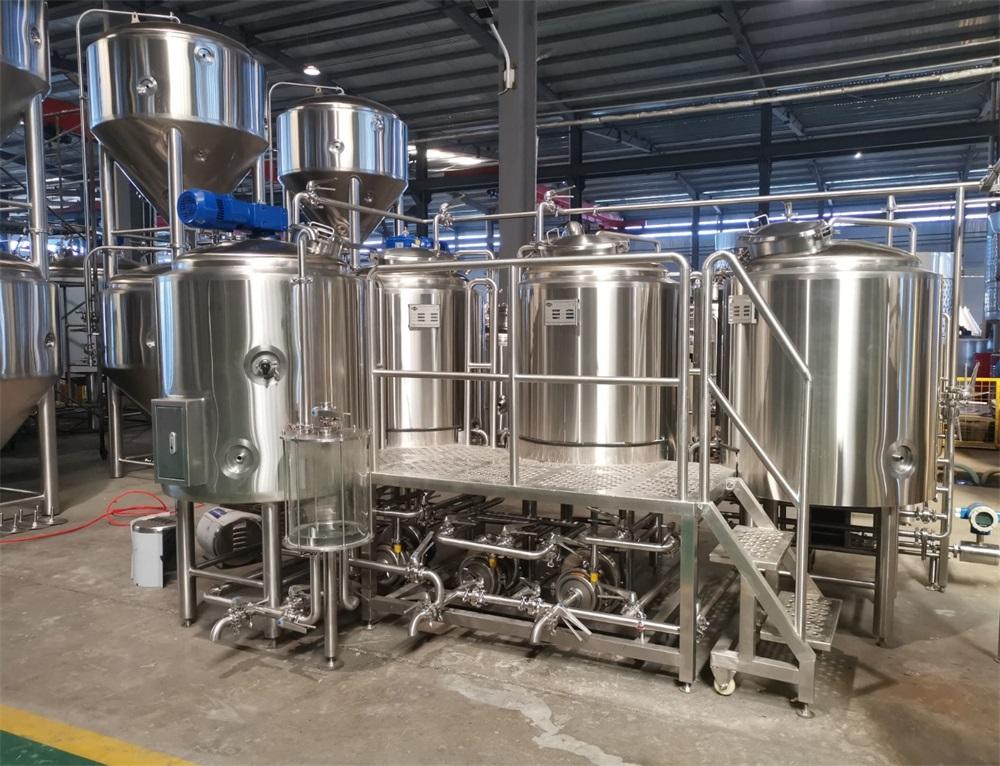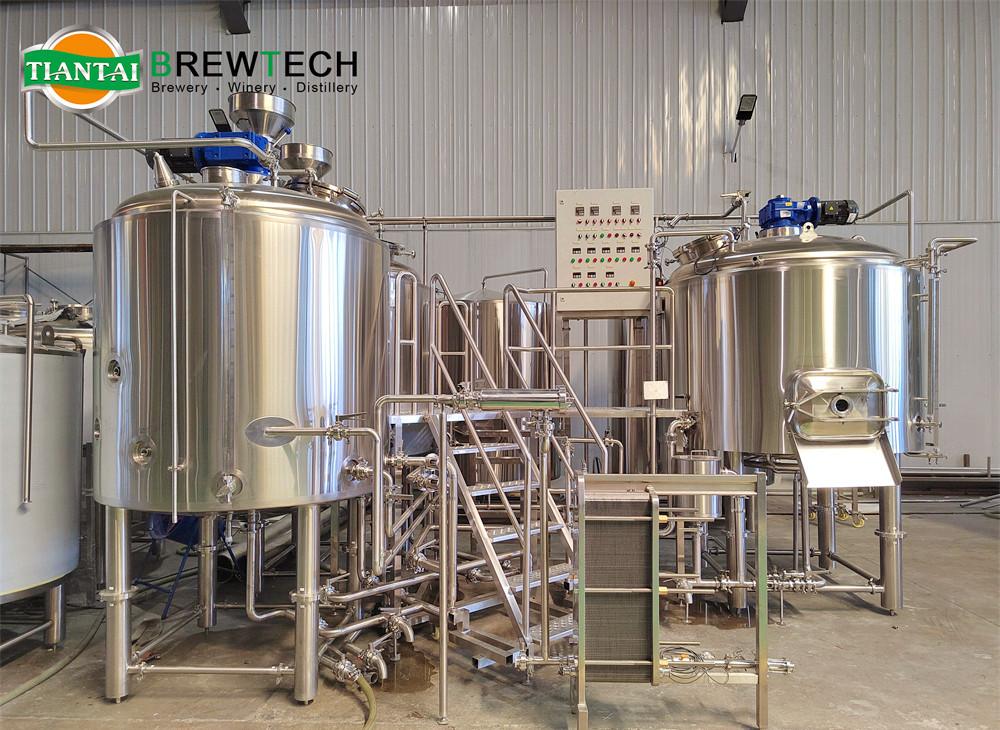.jpg)
1. Brewhouse Equipment
The brewhouse is the heart of any brewery, where the actual brewing process takes place. For a 20 million-liter brewery, high-capacity brewhouse equipment with automation features is essential to meet production demands and ensure efficiency.·
Mash Tun: The mash tun is where crushed malt is mixed with hot water to convert starches into fermentable sugars. For a high-capacity brewery, a large stainless steel mash tun with an automated mixing system will be needed to handle the substantial volume of raw materials.
·
·
Lauter Tun: The lauter tun separates the liquid wort from the solid grain husks. Large breweries often need a separate, high-capacity lauter tun to accommodate continuous production. Automated rakes or stirring systems are essential for efficient separation.
·
·
Brew Kettle: The wort is boiled in the brew kettle to sterilize the mixture and add hops. Large breweries require a high-efficiency kettle with steam jackets or external heating mechanisms to manage energy costs.
·
·
Whirlpool Tank: After boiling, the wort is transferred to a whirlpool tank to separate solid particles from the liquid. This tank should be designed for quick and efficient operation to maximize production output.
·
·
Heat Exchanger: The heat exchanger rapidly cools the wort to the proper fermentation temperature. A high-capacity plate heat exchanger with a heat recovery system is ideal for this scale, as it helps save on energy costs and ensures efficient cooling.
·
2. Fermentation Equipment
Fermentation tanks are where the wort becomes beer, so their design, capacity, and temperature control are critical. For a 20 million-liter brewery, a high number of large, conical fermentation vessels (FVs) will be needed.·
Fermentation Tanks: Typically, these are large, insulated stainless steel vessels with temperature controls. For a brewery of this size, each tank may hold tens of thousands of liters, and multiple tanks will be required to maintain the production schedule. Automated monitoring systems are essential for regulating temperature, pH, and oxygen levels.
·
·
Bright Beer Tanks: After primary fermentation, beer is transferred to bright beer tanks (BBTs) for maturation, clarification, and carbonation. These tanks should also be large, temperature-controlled, and pressurized to maintain the carbonation level.
·
·
Yeast Management System: Managing yeast health and quality is crucial for consistent fermentation. Equipment like yeast propagation tanks, storage tanks, and harvesting systems help ensure the yeast remains viable and produces the desired flavors.
·
3. Water Treatment System
Water quality significantly impacts beer quality, and for a 20 million-liter brewery, a reliable and high-capacity water treatment system is essential.·
Filtration System: This can include sediment filters, activated carbon filters, and reverse osmosis systems to remove impurities, ensuring consistent water quality for brewing.
·
·
Deaeration System: Oxygen in brewing water can lead to flavor issues, so a deaeration system is often installed to reduce dissolved oxygen.
·
·
Mineral Addition System: Some beers require specific water chemistry, so a mineral addition system allows brewers to modify water hardness and pH as needed.
·
4. CIP (Clean-In-Place) System
Cleanliness is crucial in brewing. A CIP system allows for the efficient and thorough cleaning of tanks, pipes, and other equipment without disassembly. For a brewery of this scale, a high-capacity CIP system with multiple cleaning loops and automated controls will save time and labor costs.·
Sanitizing Agents: The CIP system typically requires caustic solutions, acid cleaners, and sanitizers to effectively clean and sanitize equipment.
·
·
CIP Tanks and Pumps: These are dedicated tanks and pumps designed to hold and circulate cleaning solutions throughout the system. Automation ensures consistent cleaning and reduces manual intervention.
·
5. Packaging Equipment
Once the beer is ready, it must be packaged for distribution. For a large brewery, efficient packaging lines are crucial for handling high volumes.·
Bottling Line: This includes bottle washers, fillers, cappers, and labelers. High-speed, automated bottling lines are essential to keep up with production volume. Specialized filling systems help reduce oxygen levels during bottling, preserving the beer's quality.
·
·
Canning Line: With the popularity of canned beers, a high-capacity canning line with automated filling, sealing, and labeling is essential. A quality canning line will have low oxygen pick-up and minimal product wastage.
·
Kegging Line: Many breweries also package beer in kegs for distribution to bars and restaurants. A fully automated kegging line can clean, fill, and seal kegs quickly and efficiently.
·
Palletizing System: Once packaged, bottles, cans, and kegs need to be organized and prepared for shipping. Automated palletizing systems reduce labor costs and improve efficiency by stacking products on pallets for easy transport.
·
6. Refrigeration and Cold Storage
Beer is a temperature-sensitive product, so cold storage facilities are necessary for maintaining quality during fermentation, storage, and distribution.·
Chillers and Glycol System: A large brewery requires a robust refrigeration system, typically glycol-based, to keep tanks and rooms at the desired temperature.
·
·
Cold Storage Rooms: Finished products need to be stored at a controlled temperature before distribution. Large cold storage rooms or warehouses with proper insulation and ventilation are essential.
·
7. Quality Control Laboratory
To ensure consistent product quality, a quality control (QC) lab is vital. A QC lab allows the brewery to monitor the quality of raw materials, in-process products, and the final beer.·
Microbiology Lab: This area is for testing yeast health and monitoring for microbial contamination, such as bacteria or wild yeasts, that could spoil the beer.
·
Chemical Analysis Equipment: High-performance liquid chromatography (HPLC), spectrophotometers, and gas chromatographs help analyze bitterness, color, alcohol content, and other parameters.
·
Sensory Evaluation Room: A dedicated space for taste testing allows trained personnel to evaluate the beer's flavor, aroma, and appearance. This is essential for identifying any off-flavors or quality issues.
8. Energy Management System
A brewery of this scale has high energy demands, so an energy management system helps optimize energy consumption and reduce costs.·
Steam Boilers: Brewing requires a large amount of steam, so high-capacity boilers with efficient burners are necessary. Some breweries use renewable energy sources or waste heat recovery systems to improve energy efficiency.
·
Wastewater Treatment System: Brewing generates a significant amount of wastewater. A wastewater treatment system helps reduce the environmental impact by treating water before disposal, and some systems can recover energy or nutrients from the waste.
·
Compressed Air System: Compressed air is needed for various pneumatic processes in brewing and packaging, so a high-capacity air compressor and air treatment system are required.
·
9. Material Handling Equipment
Efficient material handling is essential for transporting raw materials, ingredients, and finished products.·
Grain Handling System: Grain handling systems move raw malt to the mash tun, often using conveyors or augers. High-capacity systems with dust control features ensure safe and efficient handling.
·
·
Automated Conveyors: These are used in various stages of production, especially in packaging, to move bottles, cans, and kegs through different stations.
·
·
Forklifts and Pallet Jacks: For moving pallets of finished products and raw materials within the facility, high-quality forklifts and pallet jacks are essential for handling the large volumes associated with high-capacity brewing.
·
10. Automation and Monitoring Systems
Automation and real-time monitoring systems help a large brewery operate efficiently and maintain consistent product quality.·
Process Control System: An integrated control system with a centralized interface allows operators to monitor and control various parameters, such as temperature, pressure, and flow rates. Programmable logic controllers (PLCs) and human-machine interfaces (HMIs) are often used for this purpose.
·
·
Data Analytics: Many breweries use data analytics platforms to monitor production data, track trends, and optimize processes. This can be especially useful for identifying inefficiencies and implementing improvements.
·


.jpg)


.jpg)

Get In Touch